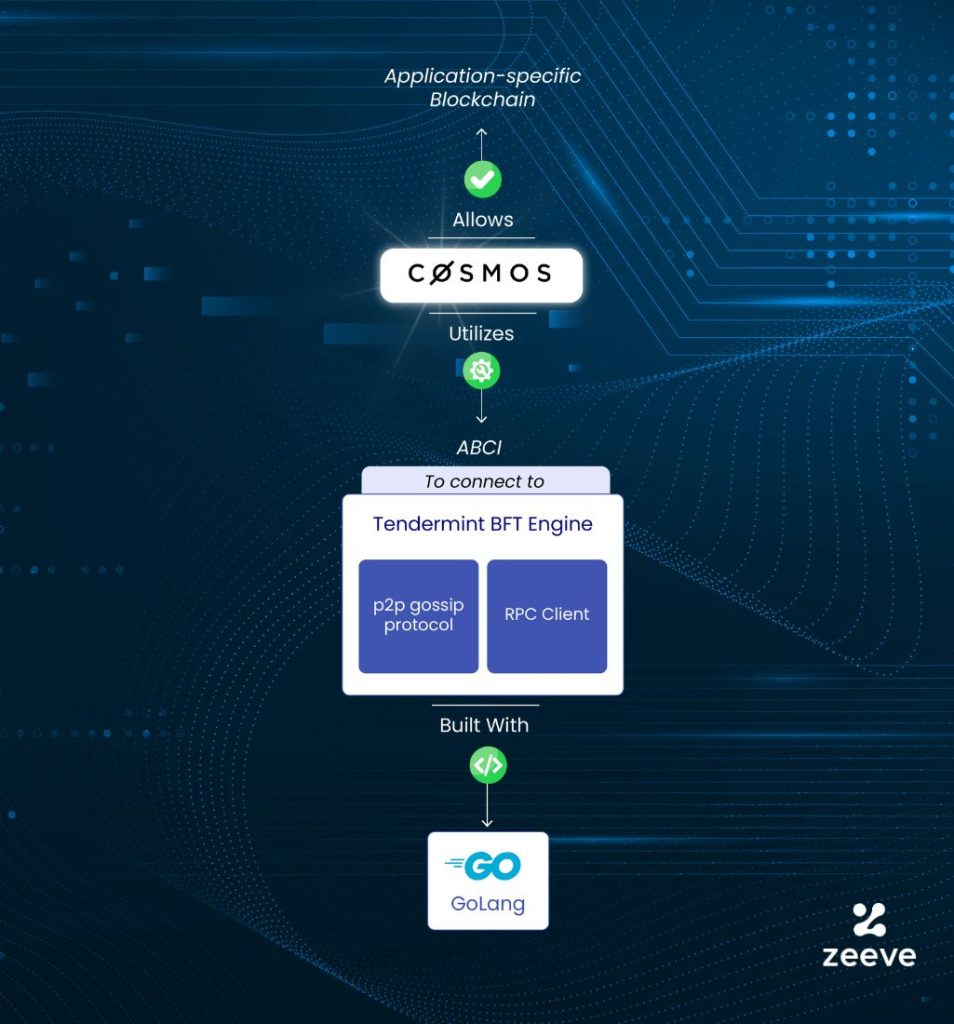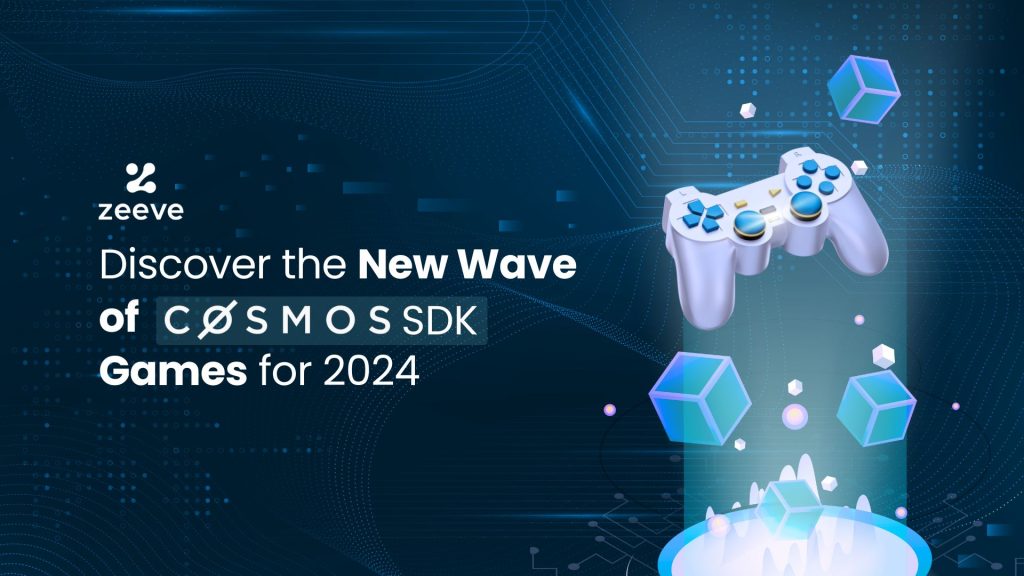The 2023 BGA State of the Industry report shows that blockchain gaming is about to take off big time in 2024. More than half of those surveyed (52.1%) think that within the next year, around 20% of the gaming industry will be using blockchain in some way. That’s really promising, and we’re already seeing it happen with more user-friendly game SDKs and building frameworks coming out. They’re making it easier to get games up and running on blockchains with ready-to-use, module-based setups. The Cosmos SDK is leading the pack here, known for helping developers create game-specific chains with its own secure environment, Tendermint core, and IBC integration.
In this article, we’ll cover the games that are being built using the Cosmos SDK, why developers are going for it, and the impact it’s having.
But before we begin, let’s do a quick walkthrough of Cosmos SDK chain architectures and what it offers for gaming.
An Overview of Cosmos Chain Architectures:

To learn more about these segments, we have two detailed articles penned down before that cover,
Why Cosmos is Powerful Framework to build custom blockchains in 2024
And: A deep dive into Cosmos network stack for AppChains
Now, let’s dive into this particular topic. For the sake of this article, we divided the newly launched Cosmos SDK-based games into 3 categories based on their primary reason for choosing Cosmos. We have also added 3 names for each of these categories and tried to analyze how this might help them.
Hopefully, this will help anyone trying to give Cosmos SDK a shot.
Let’s go.
1. Bolstering Interchain Communication Within The Gaming Environment
For the Web 3 gaming economy to transcend to the next level, gameplay simplification is pivotal. In this regard, creating cost-effective and easy-to-use interchain communication will help uplift the gaming experience. However, the real challenge comes when you are transferring an in-game NFT.
Compared to utility tokens, in-game NFTs are hard to integrate in a new gaming environment because an NFT in a separate game environment might have a different feature.
For example, VulcanForge NFTs might have a different utility than NFTs hosted on Illuvium. As a result, if game developers want to broaden the scope of their NFT integration across a wider ecosystem, they will have to set up trust bridges that act as a larger subset of the gaming ecosystem without complexities.
Cosmos Hub has been engineered in such a way that it can create simple interchain communication through IBC. Let’s see how these games benefit from using the Cosmos SDK stack for their games.
- WizWood:
WizWood is an Interchain Synthesis Z SocialFi simulation game using the Cosmos SDK to achieve cross-ecosystem interaction. The trade-off lies in advanced socialFi integration because Wizz Woods Wizards operating on the Berachain or other blockchains like Solana, Kusama, or Immutable X can create their own unique asset in their respective chain and communicate with other chains through the IBC to present their uniquely created Wizzwood NFTs for sale.
In addition, they can add specific platform-centric/blockchain-centric features to their WizzWood NFTs that would additionally drive their value. Hence, they benefit from the use of the Cosmos SDK stack, allowing them to tap into an interchain ecosystem with tons of opportunities waiting for developers and gamers.
- Monsterra:
Another gaming giant, Monsterra, is going for the Cosmos SDK stack using the AURA Network to help the Monsterra ecosystem introduce account abstraction in their gaming verse. The vision of Monsterra is to tap into the COSMOS ecosystem since Cosmos has introduced the IBC, which shall allow Monsterra’s developers to create new applications and NFTs that will be easily compatible with more than 75 other Cosmos SDK chains.
So, the Monsterra ecosystem can quickly access emerging markets using the Cosmos SDK gaming stack through the Cross-chain bridged ICS-721 developed by Stargaze. This lets the Monsterra ecosystem move closer to mass adoption because other than developer-friendly SDK, the Monsterra ecosystem’s access to the AURA Network Unity SDK makes the Monsterra Game mobile compatible, further improving its adoption by leaps and bounds.
- Andromoverse:
Stargaze NFT project is an emerging name in the NFT ecosystem They are building a Cosmos-based EVM game hub, which will drive more people to the Andromevarse ecosystem from the Cosmos and any other chains connected via the IBC. For that matter, they are using the CosmWasm instead of Solidity because they believe that Rust-based smart contracts will let them access a wider interchain environment than a Solidity-based contract, and it is more future-proof as per the changing times. Hence, despite their initial plans to switch to Polygon, the Andromoverse is developing a based EVM game hub so as not to miss access to the ever-growing gaming ecosystem built on top of the Cosmos SDK ecosystem.

2. Establishing Custom Ecosystem Infrastructure for Gaming
The gaming ecosystem is in dire need of infrastructure support to help the ecosystem mature to the next level. There are many areas to be touched on, such as fragmented community, holistic game development, and payment network support, in the most cost-efficient manner to help the gaming ecosystem reach the next level of adoption. In this regard, the Cosmos SDK stack for gaming has ended up being an amenable rescue. Here are a few games that use the Cosmos SDK stack in their own ways to give next-level infrastructure support for the gaming ecosystem to grow and thrive.
- Tabichain:
Tabichain is introducing a new communication model in the gaming realm using the Cosmos SDK stack. In the former setup, the game economy was highly fragmented. For example, there’s no direct connection between the game and the ecosystem on which it is hosted. Such a drawback leads to a lack of collaboration that impacts token functions in the game environment. To put that into perspective, a token can be more than just a payment system in the game environment.
The Tabi Chain, using the Cosmos SDK stack, introduces the FLYWHEEL Model and the Game Bribe model. In these models, the participants can use the native gaming token to vote, influence the game ranking, and even receive rewards. Thus, they address the exhaustive earning models that game developers have used all this time.
Tabi Chain, built on top of the Cosmos SDK stack, allows operations to occur at scale and in the most cost-efficient manner using the $TABI for voting and network operations. Therefore, it is becoming simpler to launch new models across a wider gaming ecosystem and reward/incentivize game developers for the long-term sustainability of the gaming ecosystem.
- Settlus:
Settlement within the game environment is another segment that is ripe for innovation. So far, we have seen that the gaming environment gives due leverage to their native tokens for settlements. For example, if you are playing Axie Infinity and have collected NFTs within the Axie Infinity ecosystem, the payment will be settled in AXIEs. Likewise, the same sentiments revolve around other gaming ecosystems like Decentraland and Sandbox. However, Krafton, the creator of PUBG, has rolled out Settlus, a web3 game built using the Cosmos SDK stack that introduces USDC for payments.
The trade-off of using USDC payments in gaming is stabilizing payments. USDC is highly transparent, which means gamers will be more likely to hold USDC in their gaming environment than native gaming tokens because the native gaming token can lose value at any moment.
The use of Cosmos SDK also opens the infrastructure that Settlus has developed to other chains, making the infrastructure accessible to other chains and allowing them to enjoy its comprehensive advantages.
- Crypto Dungeon :
Though Cosmos SDK has undoubtedly united a larger gaming environment, the sustainability of the ecosystem depends on the participation and decentralization it can create every time the chain operates. Crypto Dungeon is using the Cosmos SDK stack to build a role-playing platform to introduce the NFT auction house. These NFTs will also be used for staking to act as validators for the gaming chains to validate the transactions.
In addition to this, the Crypto Dungeon project is committing to security by using the same NFTs minted to be used as validator staking tokens to improve the game’s security. So, along with improving the game mechanism and experience within the game, these NFTs, which will be created using ADR 43 CosMEVM standards compatible with ERC-721 standards for interchain communication, will also improve the game’s security.
3. Triggering Customization Through Cosmos SDK
There cannot be a cookie-cutter approach to examining a technology stack when you are building a game on top of it. The Cosmos SDK gaming stack has decoupled that narrative by providing grass-roots level customization as per the changing game environment. Here’s how some of the games are using the Cosmos SDK stack to meet their project-specific needs, leading to the new wave of Cosmos SDK games in 2024.
- Cosmic Horizon:
A Space MMORPG game developed by Qwoyn Studios wanted to have a robust experience because it is the first space game developed using blockchain technology. To not dilute the gameplay and UX, the Cosmic Horizon ecosystem went for the Cosmos SDK because they wanted nested control within the gaming environment, like using their own gas tokens, predefining the gas, and setting a specific TPS threshold.
Cosmos SDK guarantees this without compromising the gameplay or sacrificing interoperability with other chains where such games are deployed.
So, using the Cosmos SDK, a universal design could be mirrored in the game. In addition, the Cosmos SDK gaming stack will further aid in developing solidity-based in-game assets, allowing faster NFT transfers across the Cosmos and Ethereum ecosystems.
- Six Sigma Sports:
Six Sigma Sports wanted to take sports wagering to the next level because its potential is immense, standing at $100 B. However, while making sports wagering mainstream, they also wanted to ensure that trust and transparency shouldn’t be compromised at any cost.
Cosmos SDK stack allowed the Six Sigma Group to create an SGE Network as a custom-built chain. The trade-off of CGE is a fast, low-cost, scalable, and secure ecosystem blockchain connecting different ecosystems with its bespoke concepts.
So, it was possible to build a fully customizable chain with all the features that the gaming ecosystem demanded, but it was never isolated from other chains despite achieving the application-specific requirements.
- HoneyWood:
Honeywood, a P2 E game, wanted to define its own token standards and specify the network fees. Their initial plan was to hook people to the game for 5 minutes and show them some good returns. However, that was only possible when players could get quick access to NFTs redeemable across other gaming ecosystems for utility tokens in a cost-effective way.
For that purpose, the HoneyWood ecosystem went for the Cosmos SDK gaming stack because it allowed the game to get connected to other gaming ecosystems to improve its growth potential using native tokens. Such an approach could balance the game economy because Honeywood wanted to scale 300K transactions, and the use of Cosmos SDK allows that to happen at a brisk pace and at a fraction of the cost.
Build Your Cosmos-based Game specific chain with Zeeve
Zeeve provides enterprise-grade appchain infrastructure for Cosmos SDK chains with additional dev tools and plugins. Teams can enable seamless interoperability by integrating with IBC, getting block explorers, faucets, data indexing tools, and more, along with scalable nodes and APIs for their Cosmos Chains.
Zeeve can help them launch a custom L1 blockchain quickly either from scratch or migrating from an existing blockchain network for your gaming Dapp, with minimal turnaround time and without any risk of data loss for your gaming project.
Read more about Zeeve’s appchain infrastructure-as-a-service for Cosmos SDK. Need more info? Get in touch with our web3 experts, and we will help you choose the right stack for your next project.




